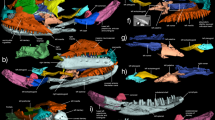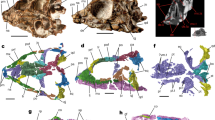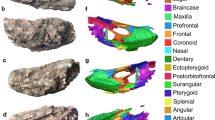Abstract
Squamates (lizards and snakes) include more than 10,000 living species, descended from an ancestor that diverged more than 240 million years ago from that of their closest living relative, Sphenodon. However, a deficiency of fossil evidence1,2,3,4,5,6,7, combined with serious conflicts between molecular and morphological accounts of squamate phylogeny8,9,10,11,12,13 (but see ref. 14), has caused uncertainty about the origins and evolutionary assembly of squamate anatomy. Here we report the near-complete skeleton of a stem squamate, Bellairsia gracilis, from the Middle Jurassic epoch of Scotland, documented using high-resolution synchrotron phase-contrast tomography. Bellairsia shares numerous features of the crown group, including traits related to cranial kinesis (an important functional feature of many extant squamates) and those of the braincase and shoulder girdle. Alongside these derived traits, Bellairsia also retains inferred ancestral features including a pterygoid–vomer contact and the presence of both cervical and dorsal intercentra. Phylogenetic analyses return strong support for Bellairsia as a stem squamate, suggesting that several features that it shares with extant gekkotans are plesiomorphies, consistent with the molecular phylogenetic hypothesis that gekkotans are early-diverging squamates. We also provide confident support of stem squamate affinities for the enigmatic Oculudentavis. Our findings indicate that squamate-like functional features of the suspensorium, braincase and shoulder girdle preceded the origin of their palatal and vertebral traits and indicate the presence of advanced stem squamates as persistent components of terrestrial assemblages up to at least the middle of the Cretaceous period.
This is a preview of subscription content, access via your institution
Access options
Access Nature and 54 other Nature Portfolio journals
Get Nature+, our best-value online-access subscription
$29.99 / 30 days
cancel any time
Subscribe to this journal
Receive 51 print issues and online access
$199.00 per year
only $3.90 per issue
Buy this article
- Purchase on Springer Link
- Instant access to full article PDF
Prices may be subject to local taxes which are calculated during checkout




Similar content being viewed by others
Data availability
All computed tomography data and three-dimensional models reported in this paper are available at MorphoSource for open download at https://www.morphosource.org/projects/00000C672.
Code availability
Our phylogenetic scripts, including full analytical settings, are available at https://doi.org/10.17605/OSF.IO/WHJT7.
References
Evans, S. E. At the feet of the dinosaurs: the early history and radiation of lizards. Biol. Rev. Camb. Philos. Soc. 78, 513–551 (2003).
Evans, S. E. & Jones, M. E. H. in New Aspects of Mesozoic Biodiversity (ed. Bandyopahyay, S.) 27–44 (Springer, 2010).
Jones, M. E. H. et al. Integration of molecules and new fossils supports a Triassic origin for Lepidosauria (lizards, snakes, and tuatara). BMC Evol. Biol. 13, 208 (2013).
Cavicchini, I., Zaher, M. & Benton, M. J. An enigmatic neodiapsid reptile from the Middle Triassic of England. J. Vertebr. Paleontol. 40, e.1781143 (2020).
Sues, H. D. & Kligman, B. T. A new lizard-like reptile from the Upper Triassic (Carnian) of Virginia and the Triassic record of Lepidosauromorpha (Diapsida, Sauria). J. Vertebr. Paleontol. 40, e1879102 (2020).
Skutschas, P. P. et al. A lepidosauromorph specimen from the Middle Jurassic (Bathonian) Moskvoretskaya Formation of the Moscow Region, Russia. Hist. Biol. 34, 566–570 (2021).
Sobral, G., Simões, T. R. & Schoch, R. R. A tiny new Middle Triassic stem-lepidosauromorph from Germany: implications for the early evolution of lepidosauromorphs and the Vellberg fauna. Sci. Rep. 10, 2273 (2020).
Estes, R., De Queiroz, K. & Gauthier, J. in Essays Commemorating Charles L. Camp. Phylogenetic Relationships of the Lizard Families (eds Estes, R. & Pregill, G.) 119–281 (Stanford Univ. Press, 1988).
Townsend, T. M., Larson, A., Louis, E. & Macey, J. R. Molecular phylogenetics of Squamata: the position of snakes, amphisbaenians, and dibamids, and the root of the squamate tree. Syst. Biol. 53, 735–757 (2004).
Vidal, N. & Hedges, S. B. The phylogeny of squamate reptiles (lizards, snakes, and amphisbaenians) inferred from nine nuclear protein-coding genes. C. R. Biol. 328, 1000–1008 (2005).
Gauthier, J., Kearney, M., Maisano, J. A., Rieppel, O. & Behlke, A. D. B. Assembling the squamate Tree of Life: perspectives from the phenotype and the fossil record. Bull. Peabody Mus. Nat. Hist. 53, 3–308 (2012).
Losos, J. B., Hillis, D. M. & Greene, H. W. Who speaks with a forked tongue? Science 338, 1428–1429 (2012).
Burbrink, F. T. et al. Interrogating genomic-scale data for Squamata (lizards, snakes, and amphisbaenians) shows no support for key traditional morphological relationships. Syst. Biol. 69, 502–520 (2020).
Simões, T. R. et al. The origin of squamates revealed by a Middle Triassic lizard from the Italian Alps. Nature 557, 706–709 (2018).
Pyron, R. A. Novel approaches for phylogenetic inference from morphological data and total-evidence dating in squamate reptiles (lizards, snakes, and amphisbaenians). Syst. Biol. 66, 38–56 (2017).
Reynoso, V. Huehuecuetzpalli mixtecus gen. et sp. nov: a basal squamate (Reptilia) from the Early Cretaceous of Tepexi de Rodríguez, central México. Philos. Trans. R. Soc. B 353, 477–500 (1998).
Villaseñor-Amador, D., Suárez, N. X. & Cruz, J. A. Bipedalism in Mexican Albian lizard (Squamata) and the locomotion type in other Cretaceous lizards. J. South Am. Earth Sci. 109, 103299 (2021).
Panciroli, E. et al. Diverse vertebrate assemblage of the Kilmaluag Formation (Bathonian, Middle Jurassic) of Skye, Scotland. Earth Environ. Sci. Trans. R. Soc. Edinb. 111, 135–156 (2020).
Evans, S. E. Jurassic lizard assemblages. Rev. Paléobiologie, Genève 7, 55–65 (1993).
Evans, S. E. A new anguimorph lizard from the Jurassic and Lower Cretaceous of England. Palaeontology 37, 33–49 (1994).
Evans, S. E. Crown group lizards (Reptilia, Squamata) from the Middle Jurassic of the British Isles. Palaeontogr. Abt. A 250, 123–154 (1998).
Waldman, M. & Evans, S. E. Lepidosauromorph reptiles from the Middle Jurassic of Skye. Zool. J. Linn. Soc. 112, 135–150 (1994).
Griffiths, E. F., Ford, D. P., Benson, R. B. J. & Evans, S. E. New information on the Jurassic lepidosauromorph Marmoretta oxoniensis. Pap. Palaeontol. 7, 2255–2278 (2021).
Ford, D. P., Evans, S. E., Choiniere, J. N., Fernandez, V. & Benson, R. B. J. A reassessment of the enigmatic diapsid Paliguana whitei and the early history of Lepidosauromorpha. Proc. R. Soc. B 288, 20211084 (2021).
Reynoso, V.-H. & Cruz, J. A. in Dinosaurs and Other Reptiles from the Mesozoic of Mexico (eds Rivera-Sylva, H. E. et al.) 4–44 (Indiana Univ. Press, 2014).
Xing, L. et al. Hummingbird-sized dinosaur from the Cretaceous period of Myanmar. Nature 579, 245–249 (2020).
Li, Z.-H. et al. Reanalysis of Oculudentavis shows it is a lizard. Vertebr. Palasiat. 59, 95–105 (2020).
Bolet, A. et al. Unusual morphology in the mid-Cretaceous lizard Oculudentavis. Curr. Biol. 31, 3303–3314 (2021).
Hoffstetter, R. & Gasc, J.-P. in Biology of the Reptilia Vol. 1 (eds Gans, C., d’A Bellairs, A. & Parsons, T. A.) 201–310 (Academic, 1969).
Dong, L., Wang, Y., Mou, L., Zhang, G. & Evans, S. E. A new Jurassic lizard from China. Geodiversitas 41, 623–641 (2019).
Conrad, J. L. Phylogeny and systematics of Squamata (Reptilia) based on morphology. Bull. Am. Mus. Nat. Hist. 310, 1–182 (2008).
Evans, S. E. in Biology of the Reptilia Vol. 20 (eds Gans. C., Gaunt, A. S. & Adler, K.) 1–347 (Society for the Study of Amphibians and Reptiles, 2008).
Moazen, M., Curtis, N., O’Higgins, P., Evans, S. E. & Fagan, M. J. Biomechanical assessment of evolutionary changes in the lepidosaurian skull. Proc. Natl Acad. Sci. USA 106, 8273–8277 (2009).
Vidal, N. & Hedges, S. B. The molecular evolutionary tree of lizards, snakes, and amphisbaenians. C. R. Biol. 332, 129–139 (2009).
Wiens, J. J. et al. Resolving the phylogeny of lizards and snakes (Squamata) with extensive sampling of genes and species. Biol. Lett. https://doi.org/10.1098/rsbl.2012.0703 (2012).
Panciroli, E. et al. Postcrania of Borealestes (Mammaliformes, Docodonta) and the emergence of ecomorphological diversity in early mammals. Palaeontology 65, e.12577 (2022).
Panciroli, E., Benson, R. B. J. & Luo, Z. X. The mandible and dentition of Borealestes serendipitus (Docodonta) from the Middle Jurassic of Skye, Scotland. J. Vertebr. Paleontol. 39, e1621884 (2019).
Caldwell, M. W., Nydam, R. L., Palci, A. & Apesteguía, S. The oldest known snakes from the Middle Jurassic-Lower Cretaceous provide insights on snake evolution. Nat. Commun. 6, 5996 (2015).
Evans, S. E. & Waldman, M. Small reptiles and amphibians from the Middle Jurassic of Skye, Scotland. Mus. N. Ariz. Bull. 60, 219–226 (1996).
Tałanda, M. An exceptionally preserved Jurassic skink suggests lizard diversification preceded fragmentation of Pangaea. Palaeontology 61, 659–677 (2018).
Evans, S. E. & Barbadillo, L. J. An unusual lizard (Reptilia: Squamata) from the Early Cretaceous of Las Hoyas, Spain. Zool. J. Linn. Soc. 124, 235–265 (1998).
Sobral, G., Simões, T. R. & Schoch, R. R. A tiny new Middle Triassic stem-lepidosauromorph from Germany: implications for the early evolution of lepidosauromorphs and the Vellberg fauna. Sci. Rep. 10, 2273 (2020).
Martínez, R. N., Simões, T. R., Sobral, G. & Apesteguía, S. A Triassic stem lepidosaur illuminates the origin of lizard-like reptiles. Nature 597, 235–238 (2021).
Ronquist, F. et al. MrBayes 3.2: Efficient Bayesian phylogenetic inference and model choice across a large model space. Syst. Biol. 61, 539–542 (2012).
Heath, T. A., Huelsenbeck, J. P. & Stadler, T. The fossilized birth-death process for coherent calibration of divergence-time estimates. Proc. Natl Acad. Sci. USA 111, E2957–E2966 (2014).
Stadler, T. Sampling-through-time in birth–death trees. J. Theor. Biol. 267, 396–404 (2010).
Carlson, K. J. et al. The endocast of MH1, Australopithecus sediba. Science 333, 1402–1407 (2011).
Mirone, A., Brun, E., Gouillart, E., Tafforeau, P. & Kieffer, J. The PyHST2 hybrid distributed code for high speed tomographic reconstruction with iterative reconstruction and a priori knowledge capabilities. Nucl. Instrum. Methods Phys. Res. B 324, 41–48 (2014).
Paganin, D., Mayo, S. C., Gureyev, T. E., Miller, P. R. & Wilkins, S. W. Simultaneous phase and amplitude extraction from a single defocused image of a homogeneous object. J. Microsc. 206, 33–40 (2002).
Lyckegaard, A., Johnson, G. & Tafforeau, P. Correction of ring artifacts in X-ray tomographic images. Int. J. Tomogr. Simul. 18, 1–9 (2011).
Acknowledgements
The work of M.T. at UCL was financed by the Mobility Plus programme (1608/MOB/V/2017/0) from the Ministry of Science and Higher Education, Poland. We thank the John Muir Trust and NatureScot for permission to carry out fieldwork on the Elgol coast Site of Special Scientific Interest under permit. We thank S. Walsh, A. Wolniewicz and R. Butler for support and assistance with fieldwork, and the Oxford University John Fell Fund and National Museums of Scotland for funding fieldwork. We thank S. Moore-Faye for partial preparation of the specimen, and L. Parry for assistance with running MrBayes on a computer cluster. Synchrotron tomography was carried out at the European Synchrotron Radiation Facility.
Author information
Authors and Affiliations
Contributions
M.T., R.J.B. and S.E.E. planned the research. R.J.B. and E.P. collected new specimens. R.J.B. and V.F. scanned the specimens. M.T. segmented the computed tomography data, wrote the description and drafted the manuscript with R.J.B. and S.E.E. M.T. and E.P. constructed the figures. M.T., R.J.B. and S.E.E. conducted the phylogenetic analysis. All authors provided feedback on the manuscript.
Corresponding authors
Ethics declarations
Competing interests
The authors declare no competing interests.
Peer review
Peer review information
Nature thanks Juan Daza, Hans-Dieter Sues and the other, anonymous, reviewer(s) for their contribution to the peer review of this work. Peer reviewer reports are available.
Additional information
Publisher’s note Springer Nature remains neutral with regard to jurisdictional claims in published maps and institutional affiliations.
Extended data figures and tables
Extended Data Fig. 1 Preserved skeleton.
A slab with visualized preserved skeleton of Bellairsia gracilis Evans, 1998 from the Middle Jurassic, Kilmaluag Formation, Skye. a, Dorsal. b, Ventral. c, Close-up of the visualized skeleton in the rock from anteroventral view.
Extended Data Fig. 2 Orbital bones.
Bones surrounding the orbit of Bellairsia. a, Right orbit in dorsal view. b, Right orbit in ventral view. c, Left orbit in dorsal view. d, Left orbit in ventral view.
Extended Data Fig. 3 Posterior skull.
Posterior part of the skull of Bellairsia. a, Dorsal view. b, Ventral view. c, left pterygoid in dorsal view. d, left quadrate in medial view. e, left quadrate in lateral view. f, left pterygoid in ventral view.
Extended Data Fig. 4 Mandible.
Right mandible (ELGOL2016 021), dentary and premaxilla (NMS G1992.47.10) from Kilmaluag Formation, Skye; frontal, left premaxilla, left dentary, maxilla from Kirtlington. a, ELGOL2016 021 mandible in medial view. b, ELGOL2016 021 in lateral view. c, ELGOL2016 021 in dorsal view. d–h, NMS G1992.47.10 preserving right dentary and premaxilla, with dentary in (d) occlusal, (f) lingual, and (h) buccal views, and premaxilla in (e) lingual and (g) buccal views. i, NHMUK PV R16331 frontal from Kirtlington in dorsal and ventral views. j, NHMUK PV R12680 left premaxilla from Kirtlington, in dorsal, lingual, and buccal views. k, NHMUK PV R12678 left dentary from Kirtlington, in posterior, lingual, and buccal views. l, NHMUK PV R12679 anterior tip of right maxilla from Kirtlington in buccal and lingual views.
Extended Data Fig. 5 Forelimb.
Left forelimb of Bellairsia. a, Whole preserved limb. b–g, Humerus in various views. h–j, Bones of the manus.
Extended Data Fig. 7 Bayesian analysis of Dataset 1 with taxa omissions.
Majority rule consensus tree from Bayesian analysis of Dataset 1 (modified from ref. 24) including molecular backbone constraint and omitting taxa with unstable phylogenetic positions that limit resolution of the consensus tree (Scandensia ciervensis and Vellbergia bartholomaei). a, Majority rule consensus including nodes with posterior probability < 0.5; b, Majority rule consensus excluding nodes with posterior probability < 0.5.
Extended Data Fig. 8 Bayesian analysis of Dataset 1 without taxa omissions.
Majority rule consensus tree from Bayesian analysis of Dataset 1 (modified from ref. 24), not omitting any taxa. a, Tree from analysis including molecular backbone constraint; b, tree from analysis with minimal backbone constraint (constraining monophyly of extant squamates relative to Sphenodon).
Extended Data Fig. 9 Bayesian analysis of Dataset 2 with molecular constraint.
Majority rule consensus tree from Bayesian analysis of Dataset 2 (modified from ref. 28) including molecular backbone constraint.
Extended Data Fig. 10 Bayesian analysis of Dataset 2 without molecular constraint.
Majority rule consensus tree from Bayesian analysis of Dataset 2 (modified from ref. 28) without molecular backbone constraint.
Supplementary information
Supplementary Information
The file includes a section on systematic palaeontology, an extended osteological description, comments on the phylogenetic analysis and results, supplementary references, and a list of synapomorphies of particular clades.
Rights and permissions
Springer Nature or its licensor (e.g. a society or other partner) holds exclusive rights to this article under a publishing agreement with the author(s) or other rightsholder(s); author self-archiving of the accepted manuscript version of this article is solely governed by the terms of such publishing agreement and applicable law.
About this article
Cite this article
Tałanda, M., Fernandez, V., Panciroli, E. et al. Synchrotron tomography of a stem lizard elucidates early squamate anatomy. Nature 611, 99–104 (2022). https://doi.org/10.1038/s41586-022-05332-6
Received:
Accepted:
Published:
Issue Date:
DOI: https://doi.org/10.1038/s41586-022-05332-6
This article is cited by
-
An exceptional fossil lizard from the Jurassic period
Nature (2022)
Comments
By submitting a comment you agree to abide by our Terms and Community Guidelines. If you find something abusive or that does not comply with our terms or guidelines please flag it as inappropriate.



